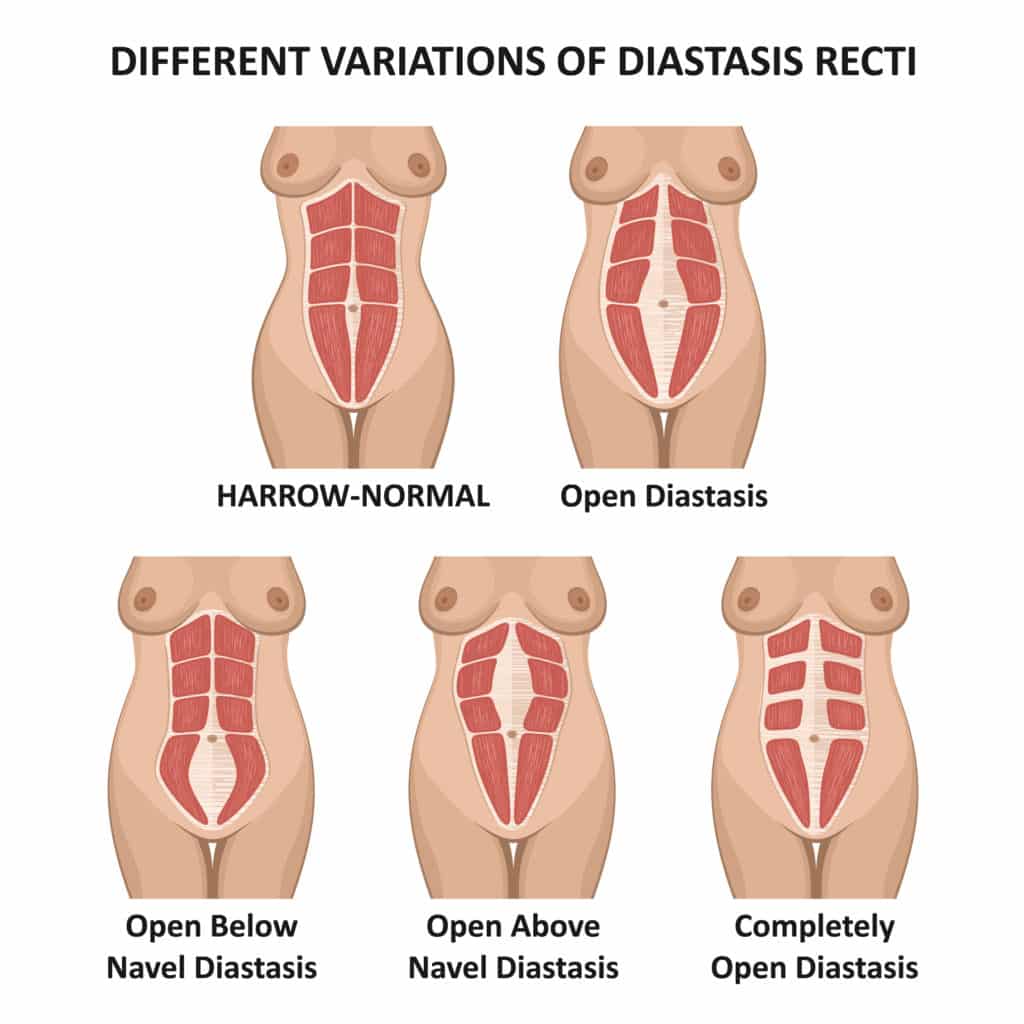8 Killer Diastasis Recti Exercises for Pregnancy & Postpartum

A term associated with the abdominal condition of pregnant and postpartum people is known as Diastasis Recti (DRA). The term refers to a condition in which a gap is developed between the left and right walls of the abdomen. The tissues responsible for holding these muscles together become weak.
Uterus size changes in pregnant women, and as the baby starts growing, the uterus stretches to accommodate the baby and causes the separation of abdominal muscles. However, this term is not only for pregnant women. It can affect others as well, like men, newborns, and adults, due to several reasons like incorrect weight lifting or performing unsafe abdominal exercises. Physical therapists can help you by suggesting diastasis recti exercises for pregnant women, adults, and infants to recover healthily.
Table of Contents
Symptoms of Diastasis Recti
Most people are unaware of diastasis recti until the postpartum period. During pregnancy, the abdomen muscles are stretched, so it is not easy to distinguish diastasis recti. So, to know about it timely, you should keenly observe the following symptoms:
- A visible belly bulge is the most common symptom. You can feel it by touching the abdomen or contracting or straining the muscles.
- Your belly may cones or domes while you lean on a chair or get up.
- You may feel your belly is extra soft, just like jelly. This flabbiness around the belly button is due to DRA.
- You may feel pain in your lower back, pelvis, or hip muscles. And sometimes, you can feel pain during sex as well.
- Not all, but some people feel urine leaking when they sneeze or cough due to DRA.
- Constipation and bloating are some of the common symptoms.
- Finding difficulty walking, lifting objects, and performing other daily routine chores.
- Feel your abdomen muscles getting weaker.
Carefully observe your body to know about your condition and start diastasis recti exercises to prevent further muscle damage. If you feel that your symptoms are getting worse or your pain is intolerable, contact your physician ASAP.
How Can You Prevent Diastasis Recti During Pregnancy?
A female body undergoes several changes during pregnancy, so avoiding diastasis recti may not be easy. However, it will be good for you to strengthen your core muscles before pregnancy or during the early stages of pregnancy. Don’t strain your abdomen excessively to keep the muscles intact and robust.
If you have constipation, get rid of it as soon as possible. Avoid lifting heavy weights to support your core muscles. Try not to perform a few exercises that utilize your abdomen, like sit-ups, crunches, planks, or push-ups.
Do not ignore your posture; a good posture during pregnancy can help you reduce the DRA effect. Place a pillow behind you to support your lower back. Last, but not least, add some pregnancy-safe diastasis recti exercises to continue strengthening your core muscles.
Another way is by consuming nutrient-dense foods, including protein-rich foods. Collagen peptides are a great source of protein, and they can help reduce your chances of developing diastasis recti.
Research shows that women with diastasis recti have decreased amounts of collagen types 1 & 3. (Blotta, et. al. 2018)
Diastasis Recti Exercises During Pregnancy
According to expert opinion, some exercises can help improve diastasis recti and should become a part of your routine before or during the initial stages of pregnancy. The diastasis recti exercises are the ones that are focused on the abdominal pull rather than letting it bulge out like in traditional plank or crunch. You can perform some exercises during pregnancy, and in a case where you still feel a bulged-out belly months after delivery, you need postpartum exercises approved by your physician.
Here we will share some pregnancy-safe exercises that you can perform at home as a warmup for your full workouts. These exercises will help you strengthen your core muscles, open up your hips, and posture improvement.
1. Forward Rolls
It is one of the diastasis recti exercises in which you need to start with a ball positioned close to you.
Exhale, bend on your knees, round your spine, tuck your chin towards your chest and slowly roll the ball outward.
Now inhale to stretch your spine and hold, lightly pressing into the ball and keeping your hips behind your knees.
Slowly press your arms into the ball and exhale as you do so, and go back to starting position by tucking your back and chin to articulate your spine.
Repeat it 4-8 times.
2. Pigeon Stretch
In this stretch using all fours, sit on the floor with your right leg bent in front of you and left knee bent behind you, giving a stretch in your outer hip without discomfort.
Support your body posture by placing your hands in front of you on the ground.
Stretch your left hand over your head in the air, scissor your hips together by bringing up on your knees.
Hold for a few seconds and inhale and lengthen your spine.
Now slowly come back to the starting position by bringing your hips down on the ground.
Repeat on the same side 2-3 times depending on your comfort, and then switch the sides.
3. Standing Rotation
Stand straight with your feet slightly rotated outward, open wider than shoulder-width apart, with your knees aligned with the feet.
Now rotate on your left while maintaining balance on your right toe and rotation coming from the left hip. Squeeze your glutes and focus on your core while stretching.
Keep moving your arms up and around your left side. After a few seconds, go back to the center.
Now repeat the same on your right side and continue for 10-12 repetitions.
While performing these exercises, always focus on your core and understand the connection between your breaths and movements. These stretches help you to avoid diastasis recti during pregnancy. And can help in improving labor, birth, and later stages.
Diastasis Recti Exercises for Postpartum
In some cases, women face the diastasis recti even after childbirth. But in this case, you have to consult your doctor if you are perfect for these stretches or exercises. Postpartum exercises generally include the following:
1. Pelvic Brace
Lie on your back with your arms resting straight on the floor and your knees bent.
Lift your feet, about 1 inch high, while contracting your lower abdominal muscles. Retain your pelvis neutral during the stretch.
Continue to stay in the position for a few minutes.
Now bring your leg down but keep the lower abdominal muscles involved.
Repeat the exercise by lifting the other leg.
Perform the 10-12 reps once a day.
2. Umbrella Breathing
Begin with a standing position with a slight bend in the knees.
Inhale and expand your ribcage like an umbrella opening 360 degrees.
Now start to exhale slowly by first emptying your lower belly, then the middle part, and finally releasing the air from the chest, engaging your abdominal muscles throughout the exercise.
Repeat the exercise 10 times.
3. C-Curving
For this exercise, sit on your sit bones and keep your hands behind your knees like you are holding them firmly and keep the legs wide apart.
Just like a rocking chair, rock back your upper body gently while keeping your chest from sinking in.
Stay in the position and exhale as you pulse backward.
Try to do 20-30 pulses, depending on your stamina.
4. Bird Dog Exercise
For this exercise, find enough space for proper arm and leg extension.
Kneel on the exercise mat in a way that your knees are hip-width apart.
Keep your hands firmly on the floor, almost shoulder-width apart.
Now form a straight line with one hand extended straight in the air and extending the opposite leg behind you.
While keeping the back straight, raise your leg only as high as you can, without sagging your lower back.
Hold in the position for a few seconds keeping your abs engaged throughout the stretch and controlling any motion in hips during weight shift.
Repeat the same with the other hand and leg.
5. Chair Position
For this exercise, you will need a chair.
Now lie down in a way that your calves are supported on the chair, and your hips and knees are at an angle of 90 degrees.
Keep your pelvis in a neutral position, maintaining the abdominal tension.
Inhale and get ready for the movement. While exhaling, lift your calves off the chair and draw in your pelvic brace. Make sure there is no bulge when you lift your calves.
Repeat chair position ten times a day.
If you feel any pain while doing these exercises, you should consult your postpartum physician to evaluate and modify your exercise program.
Final Tips
Your body needs time to heal after pregnancy. Childbirth is a critical procedure and involves a change in many muscles. Don’t panic; keep telling yourself that it takes time, be easy on yourself, and let your body heal slowly.
Once you feel your body is in a better condition, then begin your diastasis recti exercise program to rebuild and regain core strength from the inside out. If your exercise worsens your pains, discontinue and see your physician.
Try to get rid of the diastasis recti by exercise rather than opting out of surgery. However, severe cases of diastasis recti can be treated through surgery that involves the removal of the excess skin.
References:
Blotta, R. M., Costa, S., Trindade, E. N., Meurer, L., & Maciel-Trindade, M. R. (2018). Collagen I and III in women with diastasis recti. Clinics (Sao Paulo, Brazil), 73, e319. https://doi.org/10.6061/clinics/2018/e319
Originally posted 2022-03-07 20:46:34.
Megan Santiago
Latest posts by Megan Santiago (see all)
- How to break a Fever - March 10, 2024
- 5 Reasons You Need Vitamin C for Adrenal Fatigue+ Tips for Healing - January 3, 2024
- 8 Natural Research-Backed Ways to Cope if You’re a Hypochondriac - January 3, 2024
